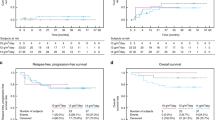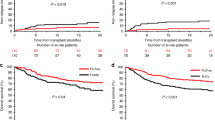Abstract
We conducted a phase I/II trial, to evaluate the efficacy and safety of an intravenous liposomal formulation of busulphan (LBu) as a myeloablative agent for stem cell transplantation (SCT). The liposomal busulphan was administered as a 3 h infusion twice daily over 4 consecutive days. Six adults received 1.6–2 mg/kg/dose and 18 children received 1.8–3 mg/kg/dose. Pharmacokinetic parameters were studied after the first and the last dose of busulphan. No significant difference in clearance, AUC, elimination half-lives or distribution volume between the first and the last dose was found in either groups. A significantly (P < 0.005) higher clearance was observed in children after the first and the last dose (3.61 and 3.79 ml/min/kg, respectively) compared to adults (2.40 and 2.33 ml/min/kg, respectively). The elimination half-lives after the first and the last dose were significantly (P < 0.005) shorter in children (2.59 and 2.72 h, respectively) compared to adults (3.35 and 3.61 h, respectively). Clearance correlated significantly with age. However, no significant correlation with age was observed when clearance was adjusted to the body surface area. Two cases of VOD following a total dose of 24 mg/kg were observed. Six patients experienced mucositis. No other organ toxicity was observed. We conclude that intravenous liposomal busulphan pharmacokinetics is age dependent. A dosage schedule based on body surface area should be used especially in young children to reduce the age-dependent difference in kinetics. An intravenous liposomal dose of busulphan of 500 mg/m2 is suggested to reach a similar systemic exposure and myeloablative effect in both children and adults. Moreover, the novel liposomal form of busulphan showed a favorable toxicity profile and seems safe as a part of the high-dose therapy prior to SCT.
This is a preview of subscription content, access via your institution
Access options
Subscribe to this journal
Receive 12 print issues and online access
$259.00 per year
only $21.58 per issue
Buy this article
- Purchase on Springer Link
- Instant access to full article PDF
Prices may be subject to local taxes which are calculated during checkout





Similar content being viewed by others
References
Blaise D, Maraninchi D, Archimbaud E et al. Allogeneic bone marrow transplantation for acute myeloid leukemia in first remission: a randomized trial of a busulfan–cytoxan versus cytoxan–total body irradiation as preparative regimen: a report from the Group d'Etudes de la Greffe de Moelle Osseuse (see comments) Blood 1992 79: 2578 2582
Blume KG, Kopecky KJ, Henslee-Downey JP et al. A prospective randomized comparison of total body irradiation–etoposide versus busulfan–cyclophosphamide as preparatory regimens for bone marrow transplantation in patients with leukemia who were not in first remission: a Southwest Oncology Group study Blood 1993 81: 2187 2193
Demirer T, Buckner CD, Appelbaum FR et al. Busulfan, cyclophosphamide and fractionated total body irradiation for autologous or syngeneic marrow transplantation for acute and chronic myelogenous leukemia: phase I dose escalation of busulfan based on targeted plasma levels Bone Marrow Transplant 1996 17: 491 495
Ringden O, Labopin M, Tura S et al. A comparison of busulphan versus total body irradiation combined with cyclophosphamide as conditioning for autograft or allograft bone marrow transplantation in patients with acute leukaemia. Acute Leukaemia Working Party of the European Group for Blood and Marrow Transplantation (EBMT) Br J Haematol 1996 93: 637 645
Santos GW, Tutschka PJ, Brookmeyer R et al. Marrow transplantation for acute nonlymphocytic leukemia after treatment with busulfan and cyclophosphamide New Engl J Med 1983 309: 1347 1353
Hartmann O, Benhamou E, Beaujean F et al. High-dose busulfan and cyclophosphamide with autologous bone marrow transplantation support in advanced malignancies in children: a phase II study J Clin Oncol 1986 4: 1804 1810
Devergie A, Blaise D, Attal M et al. Allogeneic bone marrow transplantation for chronic myeloid leukemia in first chronic phase: a randomized trial of busulfan–cytoxan versus cytoxan–total body irradiation as preparative regimen: a report from the French Society of Bone Marrow Graft (SFGM) Blood 1995 85: 2263 2268
Clift RA, Buckner CD, Thomas ED et al. Marrow transplantation for chronic myeloid leukemia: a randomized study comparing cyclophosphamide and total body irradiation with busulfan and cyclophosphamide Blood 1994 84: 2036 2043
Vassal G, Deroussent A, Challine D et al. Is 600 mg/m2 the appropriate dosage of busulfan in children undergoing bone marrow transplantation? Blood 1992 79: 2475 2479
Yeager AM, Wagner JE Jr, Graham ML et al. Optimization of busulfan dosage in children undergoing bone marrow transplantation: a pharmacokinetic study of dose escalation Blood 1992 80: 2425 2428
Vassal G, Gouyette A, Hartmann O et al. Pharmacokinetics of high-dose busulfan in children Cancer Chemother Pharmacol 1989 24: 386 390
Shaw PJ, Scharping CE, Brian RJ et al. Busulfan pharmacokinetics using a single daily high-dose regimen in children with acute leukemia Blood 1994 84: 2357 2762
Grochow LB, Krivit W, Whitley CB et al. Busulfan disposition in children Blood 1990 75: 1723 1727
Hassan M, Oberg G, Bekassy AN et al. Pharmacokinetics of high-dose busulphan in relation to age and chronopharmacology Cancer Chemother Pharmacol 1991 28: 130 134
Hassan M, Ljungman P, Bolme P et al. Busulfan bioavailability Blood 1994 84: 2144 2150
Hassan M, Ehrsson H, Ljungman P . Aspects concerning busulfan pharmacokinetics and bioavailability Leuk Lymphoma 1996 22: 395 407
Hassan M, Fasth A, Gerritsen B et al. Busulphan kinetics and limited sampling model in children with leukemia and inherited disorders Bone Marrow Transplant 1996 18: 843 850
Gibbs JP, Murray G, Risler L et al. Age-dependent tetrahydrothiophenium ion formation in young children and adults receiving high-dose busulfan Cancer Res 1997 57: 5509 5516
Gibbs JP, Liacouras CA, Baldassano RN et al. Up-regulation of glutathione S-transferase activity in enterocytes of young children Drug Metab Dispos 1999 27: 1466 1469
Hassan Z, Ljungman P, Ringden O et al. Pharmacokinetics of liposomal busulphan in man Bone Marrow Transplant 2001 27: 479 485
Andersson BS, Madden T, Tran HT et al. Acute safety and pharmacokinetics of intravenous busulfan when used with oral busulfan and cyclophosphamide as pretransplantation conditioning therapy: a phase I study Biol Blood Marrow Transplant 2000 6: 548 554
Olavarria E, Hassan M, Eades A et al. A phase I/II study of multiple-dose intravenous busulfan as myeloablation prior to stem cell transplantation Leukemia 2000 14: 1954 1959
Schuler US, Ehrsam M, Schneider A et al. Pharmacokinetics of intravenous busulfan and evaluation of the bioavailability of the oral formulation in conditioning for haematopoietic stem cell transplantation Bone Marrow Transplant 1998 22: 241 244
Hassan M, Hassan Z, Nilsson C et al. Pharmacokinetics and distribution of liposomal busulfan in the rat: a new formulation for intravenous administration Cancer Chemother Pharmacol 1998 42: 471 478
Storb R, Deeg HJ, Whitehead J et al. Methotrexate and cyclosporine compared with cyclosporine alone for prophylaxis of acute graft versus host disease after marrow transplantation for leukemia New Engl J Med 1986 314: 729 735
Hassan M, Ehrsson H . Gas chromatographic determination of busulfan in plasma with electron-capture detection J Chromatogr 1983 277: 374 380
Bearman SI, Appelbaum FR, Buckner CD et al. Regimen-related toxicity in patients undergoing bone marrow transplantation J Clin Oncol 1988 6: 1562 1568
Glucksberg H, Storb R, Fefer A et al. Clinical manifestations of graft-versus-host disease in human recipients of marrow from HL-A-matched sibling donors Transplantation 1974 18: 295 304
Slattery JT, Sanders JE, Buckner CD et al. Graft-rejection and toxicity following bone marrow transplantation in relation to busulfan pharmacokinetics (published erratum appears in Bone Marrow Transplant 1996 Oct;18(4):829) Bone Marrow Transplant 1995 16: 31 42
Pawlowska AB, Blazar BR, Angelucci E et al. Relationship of plasma pharmacokinetics of high-dose oral busulfan to the outcome of allogeneic bone marrow transplantation in children with thalassemia Bone Marrow Transplant 1997 20: 915 920
Vassal G, Deroussent A, Hartmann O et al. Dose-dependent neurotoxicity of high-dose busulfan in children: a clinical and pharmacological study Cancer Res 1990 50: 6203 6207
Grochow LB, Jones RJ, Brundrett RB et al. Pharmacokinetics of busulfan: correlation with veno-occlusive disease in patients undergoing bone marrow transplantation Cancer Chemother Pharmacol 1989 25: 55 61
Dix SP, Wingard JR, Mullins RE et al. Association of busulfan area under the curve with veno-occlusive disease following BMT Bone Marrow Transplant 1996 17: 225 230
Ljungman P, Hassan M, Bekassy AN et al. High busulfan concentrations are associated with increased transplant-related mortality in allogeneic bone marrow transplant patients Bone Marrow Transplant 1997 20: 909 913
Ringden O, Remberger M, Ruutu T et al. Increased risk of chronic graft-versus-host disease, obstructive bronchiolitis, and alopecia with busulfan versus total body irradiation: long-term results of a randomized trial in allogeneic marrow recipients with leukemia. Nordic Bone Marrow Transplantation Group Blood 1999 93: 2196 2201
Chattergoon DS, Saunders EF, Klein J et al. An improved limited sampling method for individualised busulphan dosing in bone marrow transplantation in children Bone Marrow Transplant 1997 20: 347 354
Schuler U, Schroer S, Kuhnle A et al. Busulfan pharmacokinetics in bone marrow transplant patients: is drug monitoring warranted? Bone Marrow Transplant 1994 14: 759 765
Yellowlees P, Greenfield C, McIntyre N . Dimethylsulphoxide-induced toxicity Lancet 1980 2: 1004 1006
Kinney LA, Burgess BA, Stula EF et al. Inhalation studies in rats exposed to dimethylacetamide (DMAc) from 3 to 12 hours per day Drug Chem Toxicol 1993 16: 175 194
Kennedy GL Jr, Sherman H . Acute and subchronic toxicity of dimethylformamide and dimethylacetamide following various routes of administration Drug Chem Toxicol 1986 9: 47 170
Ostro MJ, Cullis PR . Use of liposomes as injectable-drug delivery systems Am J Hosp Pharm 1989 46: 1576 1587
Gregoriadis G . Liposomes as carriers of drugs. Observations on vesicle fate after injection and its control Subcell Biochem 1989 14: 363 378
Hassan M, Ehrsson H . Urinary metabolites of busulfan in the rat Drug Metab Dispos 1987 15: 399 402
Rylance GW, Moreland TA, Cowan MD et al. Liver volume estimation using ultrasound scanning Arch Dis Child 1982 57: 283 286
Grygiel JJ, Ward H, Ogborne M et al. Relationships between plasma theophylline clearance, liver volume and body weight in children and adults Eur J Clin Pharmacol 1983 24: 529 532
Evans WE, Relling MV, de Graaf S et al. Hepatic drug clearance in children: studies with indocyanine green as a model substrate J Pharm Sci 1989 78: 452 456
Hassan Z, Hassan M, Hellstrom-Lindberg E . The pharmacodynamic effect of busulfan in the P39 myeloid cell line in vitro Leukemia 2001 15: 1240 1247
Acknowledgements
The authors thank the nursing staff on wards B87, B78 and M72, Huddinge University Hospital and nursing staff at University Children's Hospital in Zurich for all their help during the study. This study was supported by grants from the Swedish Children's Cancer Society (grant 1997/035, 1999/033) and King's Gustav V Jubilee Fund (grant 00:510).
Author information
Authors and Affiliations
Rights and permissions
About this article
Cite this article
Hassan, M., Nilsson, C., Hassan, Z. et al. A phase II trial of liposomal busulphan as an intravenous myeloablative agent prior to stem cell transplantation: 500 mg/m2 as a optimal total dose for conditioning. Bone Marrow Transplant 30, 833–841 (2002). https://doi.org/10.1038/sj.bmt.1703739
Received:
Accepted:
Published:
Issue Date:
DOI: https://doi.org/10.1038/sj.bmt.1703739
Keywords
This article is cited by
-
Comparison of Algorithms for Oral Busulphan Area Under the Concentration–Time Curve Limited Sampling Estimate
Clinical Drug Investigation (2014)
-
Age-dependent pharmacokinetic profile of single daily dose i.v. busulfan in children undergoing reduced-intensity conditioning stem cell transplant
Bone Marrow Transplantation (2009)
-
Intravenous busulfan in adults prior to haematopoietic stem cell transplantation: a population pharmacokinetic study
Cancer Chemotherapy and Pharmacology (2006)
-
Intravenous busulfan in children prior to stem cell transplantation: study of pharmacokinetics in association with early clinical outcome and toxicity
Bone Marrow Transplantation (2005)
-
I.V. busulfan in pediatrics: a novel dosing to improve safety/efficacy for hematopoietic progenitor cell transplantation recipients
Bone Marrow Transplantation (2004)



